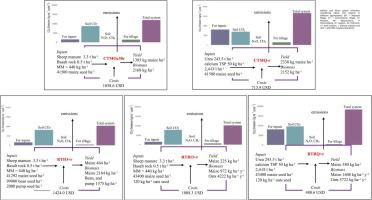Agriculture, Ecosystems & Environment ( IF 6.6 ) Pub Date : 2022-09-11 , DOI: 10.1016/j.agee.2022.108148 Mariela H. Fuentes-Ponce , Jonatán Gutiérrez-Díaz , Antonio Flores-Macías , Emmanuel González-Ortega , Alejandro Ponce Mendoza , Luis Manuel Rodríguez Sánchez , Ivan Novotny , Iván Pável Moreno Espíndola

|
Farm activities contribute to approximately one-third of Greenhouse Gas (GHG) emissions. Most of the GHG in the atmosphere comes from carbon dioxide (CO2), methane (CH4), and nitrous oxide (N2O). The main objective of this research is to investigate direct and indirect GHG emission in five different agroecosystems, contrasted by tillage agricultural, farm practices (oat and maize-fava and vetch).CO2, N2O y CH4 concentrations were measured using two closed static chambers. Total biomass and production costs were determined. Indirect emissions were calculated from fuel used in producing and packing of synthetic fertilizers and herbicide, and sheep manure mineralization. The results showed that CO2 was the gas that most contributes to GHG emissions followed by the CH4 and NO2. The agrosystem with reduce tillage and synthetic inputs had the highest emissions (979 CO2 eq kg ha−1). Agrosystems using synthetic inputs (conventional and reduce tillage) showed higher indirect emissions (958 and 856 CO2 eq kg ha−1 respectively). Maize in monoculture produced more than the systems with rotation or intercropping. Reduced tillage with intercropping and organic inputs was the most expensive to produce but had the least gas emission per dollar invested and per kilogram of biomass produced while conventional tillage agrosystems with organic or synthetic inputs stored little carbon in the soil, produced less biomass per unit area and presented higher CO2 eq emissions per unit of biomass.
中文翻译:

传统农业、有机农业和保护性农业下的直接和间接温室气体排放
农场活动约占温室气体 (GHG) 排放量的三分之一。大气中的大部分温室气体来自二氧化碳 (CO 2 )、甲烷 (CH 4 ) 和一氧化二氮 (N 2 O)。本研究的主要目的是调查五种不同农业生态系统的直接和间接温室气体排放,与耕作农业、农业实践(燕麦和玉米-蚕豆和野豌豆)形成对比。CO 2 , N 2 O y CH 4使用两个封闭的静态室测量浓度。确定了总生物量和生产成本。间接排放是根据用于生产和包装合成肥料和除草剂的燃料以及羊粪矿化计算得出的。结果表明,CO 2是对温室气体排放贡献最大的气体,其次是CH 4和NO 2。减少耕作和合成投入的农业系统排放量最高(979 CO 2 eq kg ha -1)。使用合成投入的农业系统(常规和减少耕作)显示出更高的间接排放(分别为 958 和 856 CO 2 eq kg ha -1)。单作玉米的产量高于轮作或间作系统。间作和有机投入的减少耕作生产成本最高,但每投资美元和生产每公斤生物质的气体排放量最少,而采用有机或合成投入的传统耕作农业系统在土壤中储存的碳很少,单位面积产生的生物量较少并呈现出更高的每单位生物质的CO 2 eq 排放量。



























 京公网安备 11010802027423号
京公网安备 11010802027423号